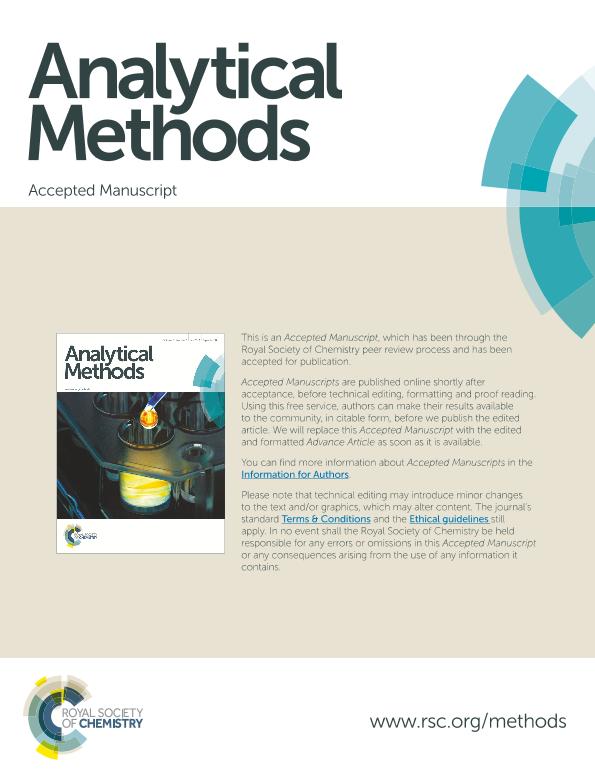Mostrar el registro sencillo del ítem
dc.contributor.author
Lozano, Valeria Antonella

dc.contributor.author
Munoz de la Peña, Arsenio
dc.contributor.author
Escandar, Graciela Monica

dc.date.available
2016-06-06T21:19:26Z
dc.date.issued
2014-11
dc.identifier.citation
Lozano, Valeria Antonella; Munoz de la Peña, Arsenio; Escandar, Graciela Monica; A second-order fluorimetric approach based on a boron dipyrromethene tetraamide derivative for Hg(II) chemosensing in water and fish samples; Royal Society of Chemistry; Analytical Methods; 6; 21; 11-2014; 8535-8543
dc.identifier.issn
1759-9660
dc.identifier.uri
http://hdl.handle.net/11336/6073
dc.description.abstract
A new fluorimetric method is described for the determination of Hg(II), based on the selectivity of a boron dipyrromethene tetraamide derivative (BODIPYTD) towards this ion, in combination with second-order chemometric analysis, to deal with matrix interferents. This is the first time that the selectivity of a mercury chemosensor regarding other metal ions is reinforced with the selectivity offered by second-order calibration, which is able to overcome the potential interference produced by organic constituents of natural or bio-samples. After the BODIPYTD–Hg(II) complex was formed, the excitation–emission fluorescence matrix was recorded and parallel factor analysis (PARAFAC) was applied for data processing. This algorithm achieves the second-order advantage and was able to overcome the problem of the presence of unexpected interferents. This method was applied to the direct determination of Hg(II) ions in environmental waters and fish muscle tissues, with minimal pretreatment steps and without the need for organic solvents. The results were successfully evaluated through a spiking recovery study in both types of real samples, which have constituents displaying fluorescence signals potentially able to interfere in the analysis. The latter fact demonstrates the excellent selectivity of the proposed method. The studied concentration range in water samples was 10–30 ng mL−1, while in fish samples it was 0.12–0.30 μg g−1. The limits of detection for water and fish samples were 2 ng mL−1 and 4 × 10−3 μg g−1, respectively, with relative prediction errors below 5%, and a sample throughput of about 8 samples per hour.
dc.format
application/pdf
dc.language.iso
eng
dc.publisher
Royal Society of Chemistry

dc.rights
info:eu-repo/semantics/openAccess
dc.rights.uri
https://creativecommons.org/licenses/by-nc-sa/2.5/ar/
dc.subject
Second-Order Fluorimetric
dc.subject
Mercury Ion
dc.subject
Bodipy
dc.subject
Water Fish Samples
dc.subject.classification
Química Analítica

dc.subject.classification
Ciencias Químicas

dc.subject.classification
CIENCIAS NATURALES Y EXACTAS

dc.title
A second-order fluorimetric approach based on a boron dipyrromethene tetraamide derivative for Hg(II) chemosensing in water and fish samples
dc.type
info:eu-repo/semantics/article
dc.type
info:ar-repo/semantics/artículo
dc.type
info:eu-repo/semantics/publishedVersion
dc.date.updated
2016-06-01T13:36:25Z
dc.journal.volume
6
dc.journal.number
21
dc.journal.pagination
8535-8543
dc.journal.pais
Reino Unido

dc.journal.ciudad
Londres
dc.description.fil
Fil: Lozano, Valeria Antonella. Consejo Nacional de Investigaciones Científicas y Técnicas. Centro Científico Tecnológico Rosario. Instituto de Química Rosario; Argentina
dc.description.fil
Fil: Munoz de la Peña, Arsenio. Universidad de Extremadura; España
dc.description.fil
Fil: Escandar, Graciela Monica. Consejo Nacional de Investigaciones Científicas y Técnicas. Centro Científico Tecnológico Rosario. Instituto de Química Rosario; Argentina
dc.journal.title
Analytical Methods
dc.relation.alternativeid
info:eu-repo/semantics/altIdentifier/url/http://pubs.rsc.org/en/Content/ArticleLanding/2014/AY/C4AY01757A
dc.relation.alternativeid
info:eu-repo/semantics/altIdentifier/doi/http://dx.doi.org/10.1039/C4AY01757A
Archivos asociados
